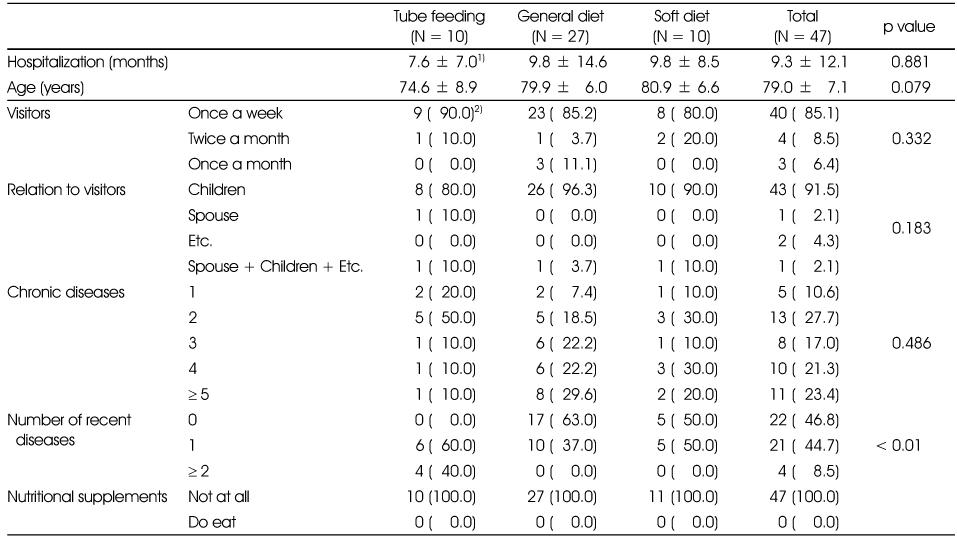References
1. Ahn HJ. The nutritional intake of elderly patients in long-term car hospital according to meal types and eating dependency Daejjin University; 2014. 39–40.
MS thesis.
2. Baik HW. Focus on nutritional assessment and nutritional support of the elderly. Korean J Med 2010;79(2):S517–S518.
3. Baik HW. Management and treatment of malnutrition in the elderly In : Proceedings of 2009 Symposium of Korean Soc Parenter Enteral Nutr; 2009. p. 135–136.
4. Bautista EN, Tanchoco CC, Tagan MG, Magtibay EV. Effect of flavor enhancers on the nutritional status of older persons. J Nutr Health Aging 2013;17(4):390–392.
5. Choi HM, Lee SI, Byun KW, Han YS, Jung SJ. What and how eating in our children? Ikkibooks; 2005. p. 28–210.
6. Cohen AJ, Roe FJ. Review of risk factors for osteoporosis with particular reference to a possible aetiological role of dietary salt. Food Chem Toxicol 2000;38(2-3):237–253.
7. D'Elia L, Rossi G, Ippolito R, Cappuccio FP, Strazzullo P. Habitual salt intake and risk of gastric cancer: a meta-analysis of prospective studies. Clin Nutr 2012;31(4):489–498.
8. Furuta M, Komiya-Nonaka M, Akifusa S, Shimazaki Y, Adachi M, Kinoshita T, Kikutani T, Yamashita Y. Interrelationship of oral health status, swallowing function, nutritional status, and cognitive ability with activities of daily living in Japanese elderly people receiving home care services due to physical disabilities. Community Dent Oral Epidemiol 2013;41(2):173–181.
10. Hur H. Nutrition screening and assessment of patients for malnutrition. J Korean Soc Parent Enter Nutr 2013;5(1):2–9.
11. Kim BH, Jung E. The changes of types of nutritional risk and nutritional intake according to depression and self-esteem among the elderly in Chunnam province. J Korean Home Econ Assoc 2008;46(8):97–107.
12. Kim EK, Nam HW, Park YS, Myung CY, Lee KW. Nutrition through the life cycle Shinkwang Publishing Co; 2007. p. 236.
13. Kim IS, Yoo HH, Kim YS. A study on nutrient intake, food behavior and health condition according to food intake diversity in the elderly in a local city. Korean J Community Nutr 2001;6(2):205–217.
14. Kim SH, Kim KS. The advantages of enteral nutrition. J Korean Soc Parent Enter Nutr 2010;3(1):3–8.
17. Korean Nutrition Society. Dietary reference intakes for Koreans. 1
st revision 2010. cited December 7, 2013. Available from
http://www.kns.or.kr.
18. Kwak KS, Bae YJ, Kim MH. Nutritional status and dietary quality in the low income elderly residing at home or health care facility. J Korean Diet Assoc 2008;14(4):337–350.
19. Lee MS, Kim MH. Medical service satisfactions of main caregivers of elderly inpatients according to the grades of long-term care hospitals. Glob Health Nurs 2013;3(2):73–81.
20. Lee JW, Lee MS, Kim JH, Son SM, Lee BS. Nutrition Assessment Seoul: Kyomunsa; 1999. p. 199.
21. Lee SS, Oh SH. Prevalence of obesity and eating habits of elementary school students in Kwangju. Korean J Community Nutr 1997;2(4):486–495.
22. Ministry of Health and Welfare, Korea Centers for Disease Control and Prevention. Korea National Health and Nutrition Examination Survey (KNHANES V-3) 2013. cited February 4, 2013. Available from
https://knhanes.cdc.go.kr/knhanes/index.do.
24. Park HK, Yim BK, Choi SH, Lee HR, Lee DS. Verification of the appropriateness when a shortened version of the mini nutritional assessment (MNA) is applied for determining the malnutrition state of elderly patients. J Korean Soc Parent Enter Nutr 2009;2(1):13–18.
25. Park JE, An HJ, Jung SU, Lee YN, Kim CI, Jang YA. Characteristics of the dietary intake of korean elderly by chewing ability using data from the korea national health and nutrition examination survey 2007-2010. J Nutr Health 2013;46(3):285–295.
26. Park JH, Kwon HK, Kim BI, Choi CH, Choi YH. A survey on the oral health condition of institutionalized elderly people resident in free asylum. J Korean Acad Dent Health 2002;26(4):555–566.
27. Paker-Eichelkraut HS, Bai-Habelski JC, Overzier S, Strathmann S, Heseker H, Stehle P, Lesser S. Nutritional status and related factors in elderly nursing home residents: comparative cross-sectional study in migrants and native Germans. J Nutr Gerontol Geriatr 2013;32(4):330–342.
28. Seo JS, Lee JH, Yoon JS, Joo SH, Choi YS. Assessment of nutritional and practice Powerbook; 2008. p. 60–81.
29. Shin BM, Bae SM, Ryu DY, Choi YK. The relationship between the number of natural teeth and nutritional status of elderly in korea-based on 2007~2009 national health and nutrition survey data-. J Korean Soc Dent Hyg 2012;12(3):521–531.
30. Stamler R. Implications of the Intersalt Study. Hypertension 1991;171 Suppl. :I16–I20.
31. Takachi T, Inoue M, Shimazu T, Sasazuki S, Ishihara J, Sawada N, Yamaji T, Iwasaki M, Iso H, Tsubono Y, Ysugane S. Consumption of sodium and salted foods in relation to cancer and cardiovascular disease: the Japan public health center-based prospective study. Am J Clin Nutr 2010;91(2):456–464.
32. Whitney EN, Cataldo CB, Rolfes SR. ndersstanding Normal and Clinical Nutrition 6th editionth ed. Wadsworth: 2002. p. 545–546.
33. Yim KS. Elderly nutrition improvement program in the community health center: nutritional evaluation of the elderly using the Index of nutritional quality and food group intake pattern. J Korean Diet Assoc 1997;3(2):182–196.
34. Yim KS. Nutrient intake assessment of korean elderly living in inje area, according to food group intake frequency. Korean J Food Cult 2008;23(6):779–792.
35. Yim YS, Cho KJ, Nam HJ, Lee KH, Park HR. A comparative study of nutrient intakes and factors to influence on nutrient intake between Low-income elderly living in urban and rural areas. J Korean Soc Food Sci Nutr 2000;29(2):257–267.
36. Yoon MO, Moon HK, Kim SY, Kim BH. Nutritional assessment and management in long-term care insurances home visit care service. Korean J Community Nutr 2013;18(2):142–153.
37. Yoon YS, Kim SM. A study on the nutritional assessment and the effects of enteral nutritional supports of tube feeding inpatients. J Korean Soc Food Sci Nutr 1996;25(5):855–864.
38. 2002;19suppl.






